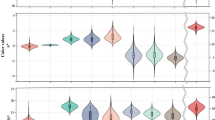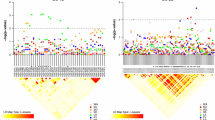Abstract
Quantitative trait loci (QTLs) influencing textural properties (hardness, adhesiveness, springiness, cohesiveness, gumminess, chewiness, and resilience)of wheat for Chinese northern-style steamed bread were studied using a doubled haploid (DH) population containing 168 lines derived from a cross between elite Chinese wheat cultivars Huapei 3 and Yumai 57 (Triticum aestivum L.). The DH population and parents were grown in 2007 and 2008 in Tai’an and 2008 in Suzhou. QTL analyses were performed using the software QTL Network version 2.0 and IciMapping v2.2 based on the mixed linear model. Thirty nine putative QTLs were detected on 14 chromosomes: viz. 1A, 2A, 3A, 4A, 6A, 1B, 2B, 3B, 5B, 6B, 7B, 5D, 6D, and 7D, and single QTLs explained 3.91–35.17% of the phenotypic variation. Eight pairs of QTLs with epistatic effects and/or epistasis × environment (AAE) effects were detected for adhesiveness, resilience, hardness, and cohesiveness on chromosomes 2A, 1B and 3D. Several co-located QTLs with additive effects were detected on chromosomes 2B, 5D, 6A, 3A, 3B and 6D. Two clusters of three QTLs for steamed bread textural properties (chewiness, gumminess, and hardness) and for adhesiveness, cohesiveness and resilience were detected on chromosome 2B. Two co-located QTLs with epistatic effects were detected on chromosomes 1B and 3A. Both additive effects and epistatic effects were important for Chinese steamed bread textural properties, which were also subject to environmental modifications. The information obtained in this study will be useful for manipulating QTLs determining Chinese steamed bread textural properties by molecular marker-assisted selection.


Similar content being viewed by others
References
American Association of Cereal Chemists (2000) Method 44-15A approved methods of the AACC, 10th edn. St. Paul, MN
BusinessStandard/commend 10139-93. Appendix A (1993) Chinese Standard publisher
Campbell KG, Finney L, Bergman CJ, Gualberto DG, Anderson JA, Giroux M, Siritunga D, Zhu J, Gendre F, Roue C, Ve′rel A, Sorrells ME (2001) Quantitative trait loci associated with milling and baking quality in a soft × hard wheat cross. Crop Sci 41:1275–1285
Cao G, Zhu J, He C, Gao Y, Yan J, Wu P (2001) Impact of epistasis and QTL × environment interaction on the developmental behavior of plant height in rice (Oryza sativa L.). Theor Appl Genet 103:153–160
Doerge RW (2002) Multifactorial genetics: mapping and analysis of quantitative trait loci in experimental populations. Nat Rev 3:43–52
Fan YD, Sun HY, Zhao JL, Ma YM, Li RJ, Li SS (2009)QTL mapping for quality traits of northern-style hand-made Chinese steamed bread. J Cereal Sci 49:225–229
Groos C, Bervas E, Chanliaud E, Charmet G (2007) Genetic analysis of breadmaking quality scores in bread wheat using a recombinant inbred line population. Theor Appl Genet 115:313–323
Guo CQ, Bai ZA, Liao PA, Jin WK (2004) New high quality and yield wheat variety Yumai 57. China Seed Ind 4:54
Hai Y, Kang MH (2007) Breeding of a new wheat variety Huapei 3 with high yield and early maturity. Henan Agric Sci China 5:36–37
He ZH, Liu AH, Peña RJ, Rajaram S (2003) Suitability of Chinese wheat cultivars for production of northern style Chinese steamed bread. Euphytica 131:155–163
Jiang XL, Hao Z, Tian JC (2008) Variations in amino acid and protein contents of wheat during milling and northern-style breadmaking. Cereal Chem 85:502–506
Kosambi DD (1944) The estimation of map distances from recombination values. Ann Eugen 12:172–175
Kuchel H, Langridge P, Mosionek L, Williams K, Jefferies SP (2006) The genetic control of milling yield, dough rheology, and baking quality of wheat. Theor Appl Genet 112:1487–1495
Lin ZJ, Miskelly DM, Moss JH (1990) Suitability of various Australian wheats for Chinese-style steamed bread. Sci Food Agric 53:203–213
Lincoln SE, Daly MJ, Lander ES (1993) Constructing genetic maps with MAPMAKER/EXP version 3.0: a tutorial and reference manual. Whitehead Inst Biomed Res Tech Rep, 3rd edn. Whitehead Institute for Biomedical Research, Cambridge, UK, p 97
Ma XQ, Tang JH, Teng WT, Yan JB, Meng YJ, Li JS (2007) Epistatic interaction is an important genetic basis of grain yield and its components in maize. Mol Breed 20:41–51
Nelson JC, Andreescu C, Breseghello F, Finney PL, Gualberto DG, Bergman CJ, Pena RJ, Perretant MR, Leroy P, Qualset CO, Sorrells ME (2006) Quantitative trait locus analysis of wheat quality traits. Euphytica 149:145–159
Perretant MR, Cadalen TG, Charmet P, Sourdille P, Nicolas C, Boeuf MH, Tixier GB, Bernard S, Bernard M (2000) QTL analysis of bread-making quality in wheat using a doubled haploid population. Theor Appl Genet 100:1167–1175
Somers, DJ, Isaac P, Edwards K(2004) A high-density microsatellite consensus map for bread wheat (Triticum aestivum L.). Theor Appl Genet 109:1105–1114
Su DM, Ding CH, Li LT, Su DH, Zheng XY (2005) Effect of endoxylanases on dough properties and making performance of Chinese steamed bread. Eur Food Res Technol 220:540–545
Voorrips RE (2002) MapChart: software for the graphical presentation of linkage maps and QTL. Heredity 93:77–78
Wang J (2009) Inclusive composite interval mapping of quantitative trait genes. Acta Agronomica Sinica 35:239–245
Yang J, Zhu J (2005) Predicting superior genotypes in multiple environments based on QTL effects. Theor Appl Genet 110:1268–1274
Zanetti S, Winzeler M, Feuillet C, Keller B, Messmer M (2001) Genetic analysis of bread-making quality in wheat and spelt. Plant Breed 120:13–19
Zhang KP, Tian JC, Zhao L (2008) A genetic map constructed using a doubled haploid population derived from two elite Chinese common wheat (Triticum aestivum L.) varieties. J Int Plant Biol 50:941–950
Acknowledgements
The authors gratefully thank Dr. C.E.(Chuck)Walker (Kansas State University) for editorial suggestions and careful reading of the manuscript. The DH population and parents were kindly provided by Professor Yan Hai, Henan Academy of Agricultural Sciences, Zhengzhou. Financial support was provided by the 973 Program of the National Nature Science Foundation of China (2009CB118301), and the National Natural Science Foundation of China (No. 30971764) from the Ministry of Science and Technology of the People’s Republic of China.
Author information
Authors and Affiliations
Corresponding author
Additional information
Peng Wu and Bin Liu contributed equally to this work.
Rights and permissions
About this article
Cite this article
Wu, P., Liu, B., Chen, J. et al. QTL analysis of textural property traits for Chinese northern-style steamed bread. Euphytica 179, 265–276 (2011). https://doi.org/10.1007/s10681-010-0304-y
Received:
Accepted:
Published:
Issue Date:
DOI: https://doi.org/10.1007/s10681-010-0304-y




